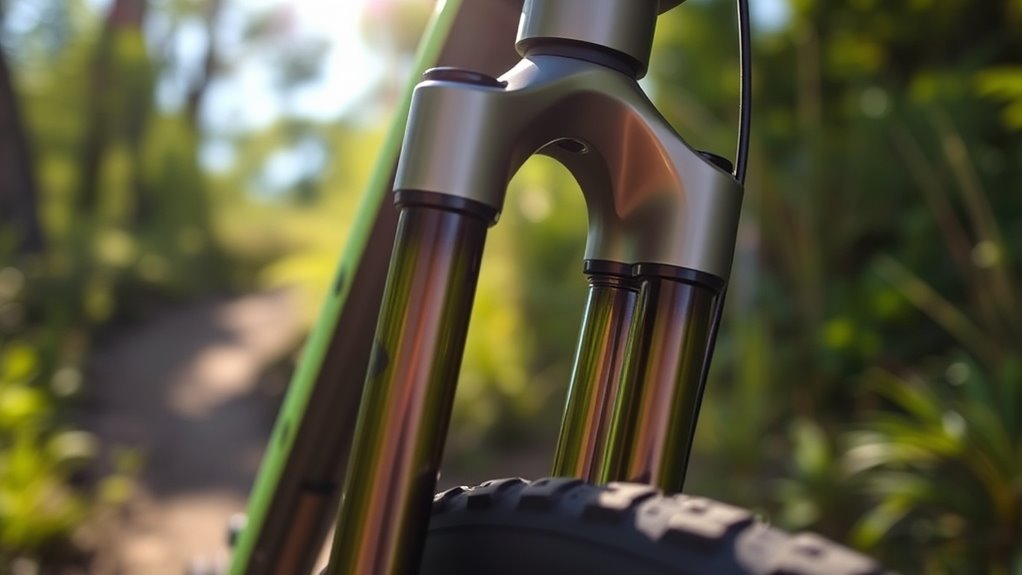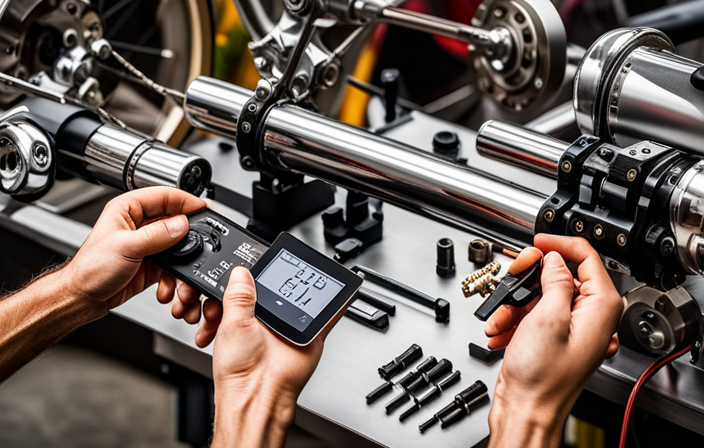Sag is how much your suspension compresses under your weight, and it’s key for smooth rides and control. Proper sag lets your bike absorb bumps without feeling harsh or feeling too soft, which can cause loss of traction. Rebound controls how quickly your suspension springs back after compression, affecting stability. If you get these settings right, your ride feels smoother, more responsive, and safer. Keep exploring to learn how to set and fine-tune sag and rebound for the best performance.
Key Takeaways
- Sag is the initial compression under rider weight, crucial for optimal suspension performance and comfort.
- Proper rebound controls how quickly the suspension returns, affecting stability and traction after impacts.
- Correct sag ensures 20-30% of suspension travel is used, balancing responsiveness and comfort.
- Over or under-adjusted rebound can cause bouncing, reduced control, or sluggish response.
- Regularly measuring and tuning both sag and rebound maintains suspension effectiveness and rider safety.
What Is Sag and Why Does It Matter?
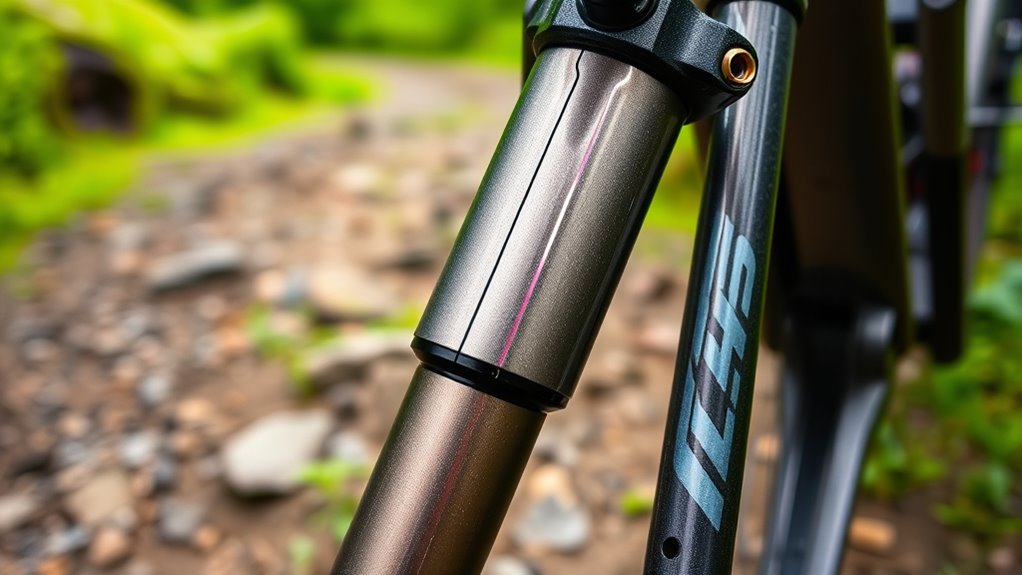
Sag refers to the amount of compression or downward movement in your suspension when you sit on or apply weight to your bike. It’s a key part of suspension tuning because it directly influences your riding comfort. When your sag is set correctly, your bike absorbs bumps smoothly, making your ride more comfortable and controlled. If the sag is too soft, your suspension may feel mushy, reducing control and increasing fatigue. Too firm, and you’ll feel every bump, leading to discomfort and less traction. Proper sag ensures your suspension responds appropriately to your weight and riding style. By understanding and adjusting sag, you optimize your bike’s performance, enhance riding comfort, and make every ride more enjoyable. This simple adjustment has a big impact on your overall riding experience.
How to Measure and Set Your Bike’s Sag Correctly
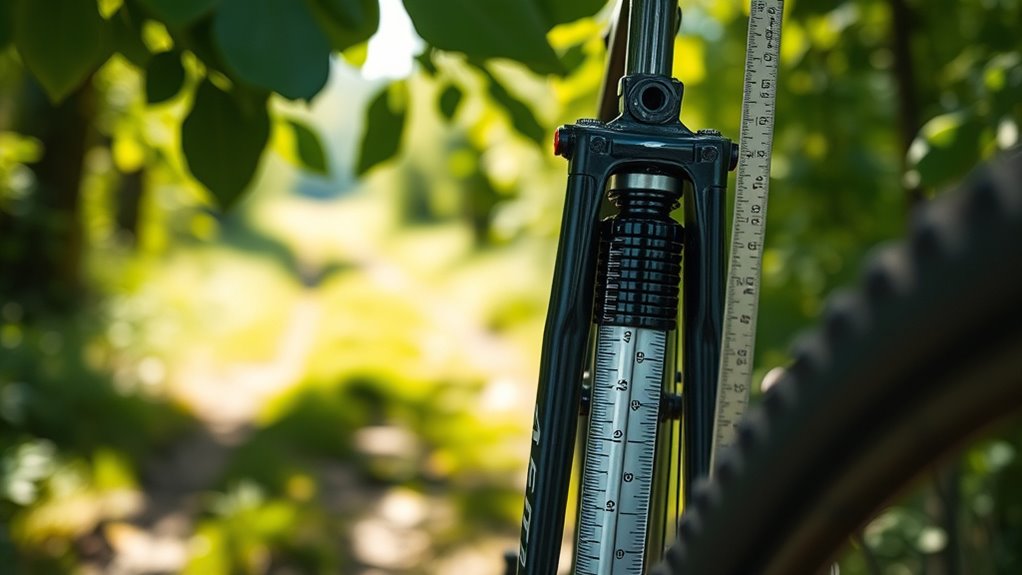
To measure and set your bike’s sag accurately, start by positioning yourself on the bike in your typical riding stance with all your gear on. Find a flat surface, then gently sit on the bike without bouncing. Use a friend or mirror to mark the position of the suspension at rest and when you’re seated. Adjust the preload or air pressure to achieve the correct sag, which is usually around 20-30% of total travel. Proper suspension tuning ensures ideal performance and comfort. Tracking your progress can be emotional, knowing you’re enhancing your ride. Here’s a quick guide:
| Step | Action | Result |
|---|---|---|
| 1 | Sit naturally on the bike | Find baseline sag |
| 2 | Mark suspension position | Measure accurately |
| 3 | Adjust preload/air pressure | Achieve perfect sag |
| 4 | Recheck and fine-tune | Smooth ride, better control |
| 5 | Regularly monitor | Maintain perfect suspension |
Proper bike maintenance and suspension tuning boost confidence and riding joy. Remember that suspension setup is critical for both safety and optimal handling, especially when riding on varied terrain.
The Role of Rebound in Suspension Performance

Have you ever wondered how your suspension responds after absorbing a bump? Rebound plays a vital role in suspension tuning because it controls how quickly the shock or fork returns to its original position. If rebound is too fast, your wheel might bounce, reducing traction and causing a rough ride. Too slow, and your suspension may feel sluggish, affecting rider comfort and control. Proper rebound adjustment guarantees the suspension recovers smoothly, maintaining contact with the ground and absorbing subsequent impacts efficiently. This balance directly impacts rider comfort by preventing unnecessary bouncing and keeping the bike stable. Understanding how rebound influences suspension performance helps you fine-tune your ride, making every bump feel less harsh and increasing confidence on varied terrain. Wall organization solutions can also help keep your bike setup tidy and functional, enhancing overall riding experience.
Adjusting Rebound: Tips for a Smoother Ride

Adjusting rebound effectively starts with understanding your suspension’s settings and how they impact ride quality. Proper suspension tuning ensures your bike responds smoothly to terrain, enhancing rider comfort. To fine-tune rebound, start by turning the adjustment knob slowly, testing how your bike reacts after each change. If the suspension rebounds too quickly, it can feel bouncy and unstable; if too slow, it may feel sluggish and unresponsive. Find a balance where the suspension recovers without bouncing excessively. Remember, small adjustments make a big difference. Pay attention to how your bike handles different terrains, and always test ride after each tweak. This methodical approach helps you achieve a smoother ride, making your cycling experience more comfortable and controlled. Additionally, understanding suspension settings can greatly improve your ability to customize your ride for various conditions.
Common Mistakes Riders Make With Sag and Rebound

Many riders overlook common mistakes when setting sag and rebound, which can lead to a less comfortable and less controlled ride. Overconfidence errors often cause riders to ignore proper measurements, relying on guesswork rather than precise adjustments. They might think they know their perfect settings without testing thoroughly, resulting in poor handling. Equipment neglect is another frequent mistake—failing to maintain or upgrade suspension components can compromise performance. Some riders set rebound too fast or too slow without understanding the impact, which can cause instability or a harsh ride. These errors highlight the importance of paying attention to proper setup rather than rushing through adjustments. By avoiding overconfidence and neglect, you’ll improve your bike’s responsiveness, comfort, and overall riding experience. Regularly checking your suspension’s glycolic acid benefits ensures optimal performance and longevity.
How Proper Settings Improve Handling and Comfort
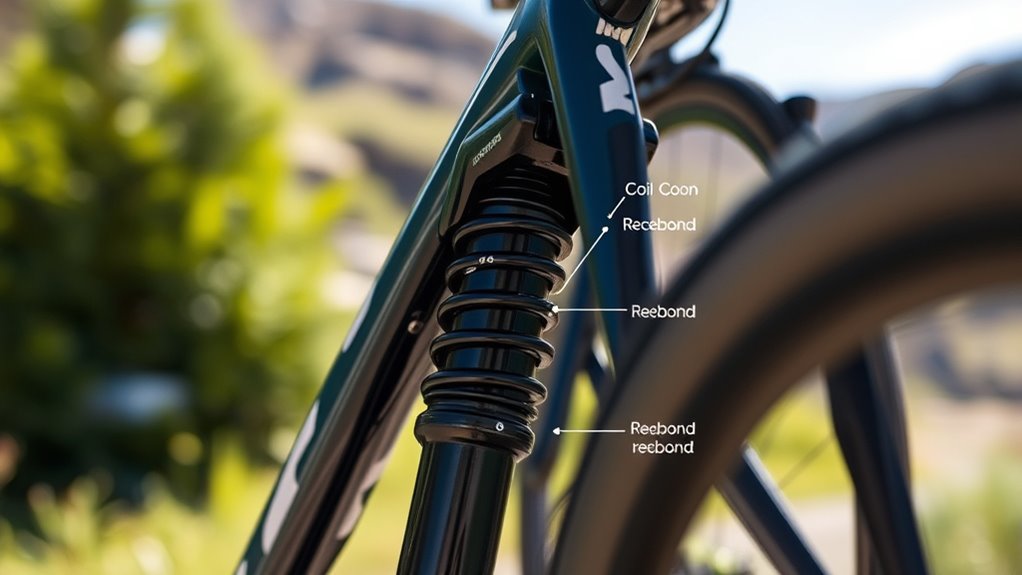
When your suspension settings are properly dialed in, your bike responds more predictably and smoothly to your movements. This leads to improved handling, especially on rough terrain or technical sections. Proper settings also enhance comfort by reducing unnecessary impacts and vibrations. Regular bike maintenance ensures your suspension performs at its best, preventing issues caused by dirt or wear. Additionally, maintaining good rider posture helps you stay balanced and makes it easier to fine-tune your suspension. When your sag and rebound are correctly adjusted, you’ll notice a more natural feel, less fatigue, and better control. Kia Tuning techniques can also influence vehicle handling, highlighting the importance of precise adjustments. Ultimately, investing time in setting your suspension correctly makes every ride safer, more comfortable, and more efficient.
Tools and Techniques to Fine-Tune Sag and Rebound

You can use specific tools like sag gauges and rebound meters to guarantee your suspension settings are accurate. Adjusting rebound properly involves paying attention to your bike’s response after compression, ensuring it rebounds smoothly without bouncing. Remember, consistent measurement methods help you fine-tune your suspension for ideal performance and comfort. Incorporating suspension tuning techniques can further refine your adjustments for a smoother ride.
Sag Measurement Methods
To accurately measure sag and rebound, selecting the right tools and techniques is essential. For effective suspension tuning and shock setup, you need reliable methods to gauge how much your suspension compresses under your weight. One common technique is using a tape measure or ruler to mark the suspension’s static length and then measure how much it compresses when you’re seated on the bike. Some riders use a dedicated sag ruler or shock pump with measurement markers for more precision. Additionally, a friend can help stabilize the bike while you sit in your riding position. Proper suspension setup ensures your bike performs optimally across various terrains. Consistent measurements ensure your suspension is correctly set, improving comfort, control, and overall bike performance. Accurate sag measurement is a cornerstone of ideal suspension tuning.
Rebound Adjustment Tips
Fine-tuning rebound is essential for maintaining control and stability during your ride, and using the right tools makes the process much easier. To optimize suspension maintenance, start by adjusting rebound settings based on rider weight considerations. Heavier riders typically need slower rebound to prevent the suspension from bouncing excessively, while lighter riders benefit from faster rebound for better responsiveness. Use a rebound adjustment tool, such as a small screwdriver or dial, to make precise changes. Test your adjustments by riding over rough terrain, paying attention to how quickly the suspension recovers after compression. Small, incremental tweaks help avoid over- or under-damping. Proper rebound adjustment enhances traction and comfort, making your ride safer and more enjoyable. Regularly fine-tuning rebound ensures your suspension performs at its best, and understanding suspension dynamics can help you make more informed adjustments.
Frequently Asked Questions
How Often Should I Check and Adjust My Bike’s Sag?
You should check and adjust your bike’s sag before every ride or at least weekly if you ride often. Regular shock maintenance keeps your suspension tuned for peak performance. During each check, verify the sag is within the recommended range and make adjustments if needed. Proper suspension tuning enhances comfort and control, so don’t skip these routine checks to keep your bike performing at its best.
Can Incorrect Rebound Settings Cause Bike Damage?
Incorrect rebound settings can definitely harm your bike. If rebound is too slow or fast, it puts extra strain on your suspension components, reducing suspension longevity. This can lead to premature wear or damage. Plus, improper rebound affects riding comfort, making your ride rough or unstable. Always fine-tune your rebound to match your riding style, ensuring both smoother rides and better suspension durability.
Is There a Universal Rebound Setting for All Terrains?
Did you know that 85% of riders don’t optimize their suspension rebound settings? There’s no universal rebound setting for all terrains because suspension calibration depends on terrain adaptation. You need to adjust rebound based on whether you’re tackling smooth trails or rough downhill sections. Using a single rebound setting can lead to poor handling or suspension damage, so always tailor your settings for the specific terrain you ride.
How Does Rider Weight Affect Sag and Rebound Adjustments?
Your rider weight notably impacts suspension tuning, especially sag and rebound settings. Heavier riders need more sag to prevent harsh impacts and slower rebound to control compression, while lighter riders require less sag and faster rebound for ideal performance. Adjusting these settings based on your weight guarantees your suspension reacts properly, offering comfort and control on varied terrains. Always fine-tune your suspension to match your rider weight for the best ride experience.
What Are Signs of Poor Suspension Setup During Riding?
Did you know that poor suspension setup can reduce your bike’s efficiency by up to 20%? If you notice suspension noise or uneven tire wear, these are signs your setup’s off. You might also feel excessive bouncing or a harsh ride. These issues indicate your suspension isn’t functioning properly, making your ride uncomfortable and less safe. Regularly check and adjust your suspension to keep everything running smoothly.
Conclusion
Mastering sag and rebound is like revealing the secret to riding on air—your bike becomes an extension of you, gliding effortlessly over every bump. When you get these settings right, you’ll experience a smoother, more controlled ride that feels almost magical. Don’t settle for bumpy, uncomfortable journeys—fine-tune your suspension, and watch as your riding transforms from ordinary to epic. Get it right, and ride like the legend you’re meant to be.
